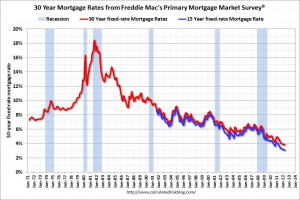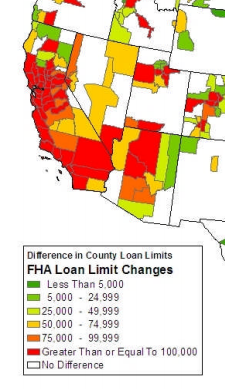If you took out a 5 year ARM loan just under 5 years ago, your rate is getting ready to ‘float to market’. In this environment, that’s a good thing.
ARM loans are typically structured as 30 year loans with fixed rate periods of 3, 5, 7, or 10 year periods. At the end of the specified period, the rate becomes adjustable. There are predetermined rules for the adjustment parameters that govern:
- What financial index the rate is tied to
- What the margin is
- How frequently it will adjust
- How far it can adjust on the initial adjustment
- How far it can adjust on each consecutive adjustment
- How far it can adjust over the duration of the 30 year term
Most ARMs can adjust a maximum of 5.000% (sometimes 6.000%) above their initial ‘start’ rate. This cap applies to both the first and usually the lifetime adjustment. Interim adjustments after the initial one are most often either 1.000% or 2.000% max.
So if you started at 5.000%, it’s possible that you could adjust to 10.000% or even 11.000% on the first adjustment date. That would be the fastest route to a worst case scenario. But to be able to see something like this coming, you need to understand what index your loan is tied to, and where it is.
Typical ARMs are built with a 2.25% to 2.75% margin, and tracks the 1 year LIBOR and adjust 1 time per year. Sometimes 2 times per year, in which case they might be tracking the 6 month LIBOR.
What the heck’s a LIBOR? Allow me to introduce you to wikipedia, if you want to know more. Then you can come back here and continue.
Here’s the good news. LIBOR is super-low right now. It has been for a while. Typical ARM loans resetting in this environment are landing between 2.750% and 3.250% for their rate resets. A 5 year ARM was getting close to 6.000% 5 years ago, so if you’re in one of those, get ready to see your rate drop in half.
But there’s something worth keeping an eye on here. During the Financial Crisis of 2008, LIBOR was spiking. Referring back to the wikipedia definition will help understand why. Banks were facing liquidity issues, and nobody wanted to lend money to anyone. One measure used to gauge the health of LIBOR was the “Ted Spread“. You can see how quickly the spread spiked during the onset of the crisis – that spike was because of a skyrocketing LIBOR.
In contrast to today’s environment, an ARM loan resetting in 2008 was looking to land close to 8.000%
So all is well and good in the resetting ARMs world. At least for near term planning; remember, ARMs reset each year, so your ~3.000% rate will be great until it resets, then you’re back to the current market.
Wait just a second… Why you might want to be looking out
Right now there’s a slow motion train wreck happening in the Euro Zone economy. Check out Jim Cramer on CNBC getting heated in a debate about whether there’s a liquidity crisis and inter-bank contagion risk brewing. Clearly, these are uncertain times. I think that if you’re facing an ARM reset, you need to be a little cautious in the coming months, and make sure you’re not landing on a LIBOR spike.
At the moment, LIBOR is relatively calm. It’s still really really low, though it has risen a little. But what if some event sparks a contagion fest in the Euro Zone? The entire world economy is on such thin ice it seems. I think you just have to keep an eye on it.
Consider making a lateral move into a fixed rate loan while the rates are so low. When LIBOR is headed higher, and you want out of that adjustable loan, the low fixed rate environment will have already left the station. You have to be forward-facing with this.
Some further food for thought about the relative calm of LIBOR in the face of what is happening in Europe. This is settling, but I would worry about how quickly it could all change. This is from highly regarded industry writer Rob Chrisman on Mortgage News Daily:
In this era of low mortgage rates, few borrowers are opting for ARM loans. We all know that at some point that will change and lenders will all have to dust off their ARM margin notes and remember things like LIBOR, created in the 1980’s. The London Interbank Offered Rate is a key adjustable rate mortgage index, but also helps price trillions of dollars of derivatives and corporate loans. Calculated daily, Libor (not all in caps) is supposed to measure borrowing costs for a panel of banks globally. The rate “floats,” or ebbs and flows depending on how much banks charge one another. At the height of the financial crisis in 2008, Libor was one of the most-watched indicators, as nervous investors looked at its sharp rise as a sign of waning confidence in the stability of the global financial system. These days, however, two key Libor gauges are being suppressed because of sharply shrinking demand since banks have a lot of cash, and don’t need to borrow from each other. Libor rates are very low, and have failed to reflect turmoil in the bank markets amid the European debt crisis. (In the 2008 financial crisis, by contrast, the rate rose to about 4.82% from 2.81% in a six-week period.)
For consumers and companies, low Libor is good news because some home, student and corporate loans, among other things, are tethered to Libor. Just think of all those resetting ARM loans (although the impact depends on margins). Most U.S. auto and credit-card loans are set against the prime rate, however, which now stands at 3.25% and often have margins in the teens.
The British Bankers’ Association “oversees” Libor, and has some reasons why Libor is so low and why banks are borrowing less from one another in the Libor market. In the U.S. and Europe, regulators have given banks cheap access to their lending facilities since the 2008 panic. And depositors are parking their money in banks – who needs to borrow outside aside from banks with end-of-month funding needs? Retail deposits are desirable because they are stable. The Fed has a lot of cash now (which they could use to buy bonds) which also keeps Libor low: there is a massive liquidity cushion.
You know the extreme low on adjustable loans can’t hold up indefinitely. With fixed rates down all around you, it’s as good a time as ever to consider locking something in for the long haul.






